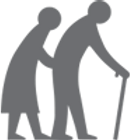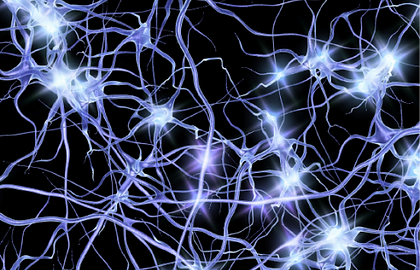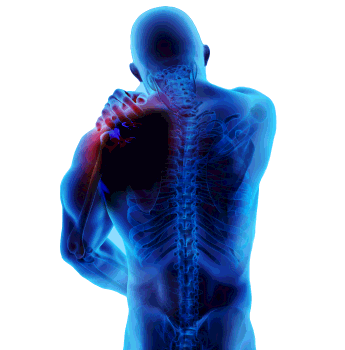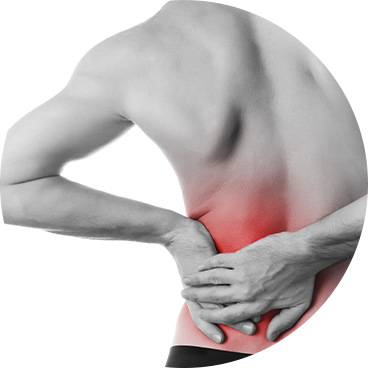Lower back pain is an extremely common health condition involving ligaments, small joints, muscles, tendons and/or nerves of the back (1). It can involve a mixture of nociceptive pain (pain arising from tissue damage or injury), and neuropathic pain (nerve pain), known as mixed pain (1),(2). This condition may be caused by compression to nerves and/or inflammation in the spine (3).
A number of conditions can cause lower back pain with a nerve pain component including (3):

Slipped disc

Narrowing of the
back bone

Complicated/
failed spinal/
back surgery

Spinal cord injury
HOW COMMON IS LOWER BACK PAIN WITH A NERVE PAIN COMPONENT?
Lower back pain is one of the more commonly experienced types of pain (4). Lower back pain that won’t go away may have a neuropathic, or nerve pain component.
It is important to describe your symptoms to your doctor, as this is the first step towards getting the right help.


Up to 4 in 5 people experience lower back pain at some point in their lives (4).

Between 20–35% of people with low back pain experience nerve pain (3).

Up to an estimated 2 in 5 elderly patients (aged ≥65 years) with chronic lower back pain have nerve pain (5).
Lower back pain is a complex condition that can involve a mixture of pain resulting from tissue damage or injury (nociceptive pain) and nerve pain (1).
The nerve pain component in lower back pain is often described as tingling, pins and needles, burning, freezing, stabbing, shooting, or electric shocks (6). This pain can be constant, or may come and go, may radiate to the arm or leg, and often gets worse at night (7).

Electric shocks

Shooting/ stabbing

Burning/ On fire

Tingling/ pins & needles

Freezing

Pain radiating to
the arm or leg
Painful areas may become abnormally sensitive if you have nerve pain. For example, sensations that would usually not cause pain, such as clothes brushing against your skin or a cold draught of air, can be intensely painful experiences (6).
DON'T IGNORE YOUR PAIN
Lower back pain can negatively impact your quality of life (3). In addition to pain, a delay in treatment or misdiagnosis of the nerve pain component may lead to the development of other conditions including (8):

Anxiety

Sleep disorders

Depression
There are specific treatments available for the nerve pain component of lower back pain.
If you think you have lower back pain with a nerve pain component, make an appointment to see your doctor.
If you have pain that won’t go away, it’s important to get help.

HOW DOES NERVE PAIN DIFFER FROM OTHER PAIN?
Nerve pain experienced in the lower back differs from other types of pain because it directly affects the nervous system (2).
Usually, pain is the way our nervous system tells us that there is damage to a part of our body. This is called “nociceptive” pain. Unlike nociceptive pain, nerve pain arises as a result of disease or damage to the nerve itself. Nerve pain is also referred to as “neuropathic” pain. Both nociceptive and neuropathic pain can be present at the same time, which is known as mixed pain (2).
People with nerve pain may experience symptoms of stabbing, shooting or electric shocks (3). These are signs of nerve damage and are unlikely to occur with other types of pain (2).

KNOW SOMEONE WITH BACK PAIN?
Perhaps you know someone with symptoms that sound like low back pain with a nerve pain component? If so, there are practical steps you can take to help someone experiencing ongoing pain.

References
- Freynhagen R, et al. PainDETECT: A New Screening Questionnaire to Identify Neuropathic Components in Patients with Back Pain. Curr Med Res Opin. 2006;22:1911-1920.
- Haanpää ML, et al. Assessment of Neuropathic Pain in Primary Care. Am J Med. 2009;122(10Suppl):S13-21.
- Freynhagen R, et al. The Evaluation of Neuropathic Components in Low Back Pain. Curr Pain Headache Rep. 2009;13(3):185-190.
- Walker BF. The Prevalence of Low Back Pain: A Systematic Review of the Literature from 1966 to 1998. J Spinal Disord. 2000;13(3):205-217.
- Sakai Y, et al. Neuropathic Pain in Elderly Patients with Chronic Low Back Pain and Effects of Pregabalin: A Preliminary Study. Asian Spine J. 2015;9(2):254-62.
- Freynhagen R, et al. Diagnosis and Management of Neuropathic Pain. BMJ. 2009;339:b3002.
- Meyer HP. Neuropathic Pain - Current Concepts. SA Fam Pract. 2008;50(3):40-49
- Harden N, et al. Unmet Needs in the Management of Neuropathic Pain. J Pain Symptom Manage. 2003;25(5 Suppl):S12-17.



 HOME
HOME

